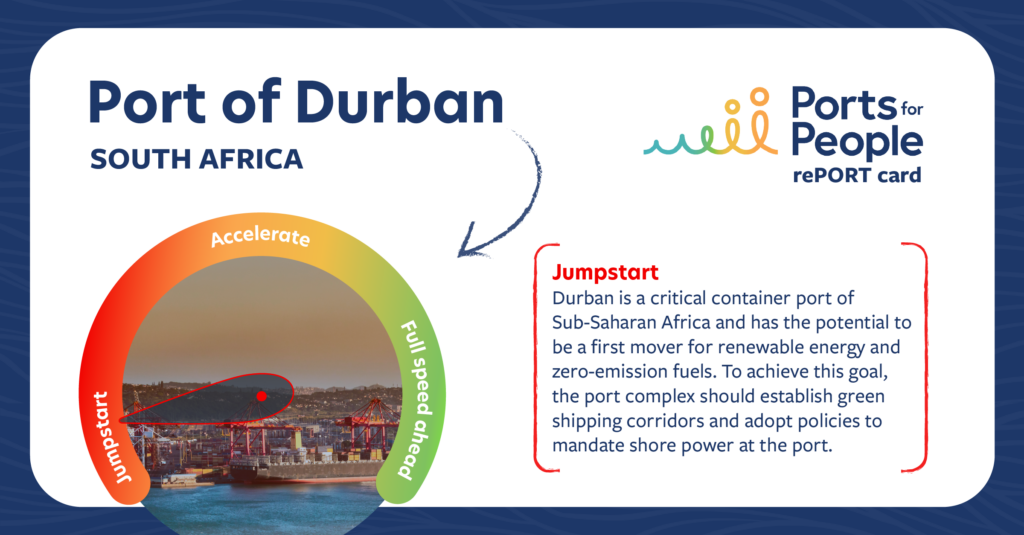Ports for People is on a mission to end port and ship pollution. Our Ports Playbook for Zero-Emission Shipping details nine actions that ports can take to accelerate the transition to zero-emission shipping by 2040. By implementing these bold commitments, progressive policies and immediately actionable progress steps, ports can ignite a chain reaction in the shipping supply chain to build and deploy zero-emission vessels. But to move forward, we must know our starting point.
Ports for People RePORT Cards
Introduction
Ports for People is on a mission to end port and ship pollution. Our Ports Playbook for Zero-Emission Shipping details nine actions that ports can take to accelerate the transition to zero-emission shipping by 2040. By implementing these bold commitments, progressive policies and immediately actionable progress steps, ports can ignite a chain reaction in the shipping supply chain to build and deploy zero-emission vessels. But to move forward, we must know our starting point.
For our inaugural Ports for People RePORT Cards, we selected 15 ports among the world’s top 50 container ports and key ports in regions around the globe. As anchors of global trading routes, these ports serve as critical triggers in the transition to zero-emission shipping. To gauge their progress toward decarbonization, we evaluated each port’s commitments, policies and progress steps that target emissions from shipping. Through this report, we demonstrate how these ports can build upon their decarbonization efforts to date and lead their nation and region on shipping decarbonization.
Ports Evaluated
- Busan, Republic of Korea
- Colón, Panama
- Durban, South Africa
- Hong Kong, S.A.R., China
- Klang, Malaysia
- Long Beach, CA, USA
- Los Angeles, CA, USA
- Manzanillo, Mexico
- Oslo, Norway
- Rotterdam, The Netherlands
- Santos, Brazil
- Shanghai, China
- Singapore
- Tanger Med, Morocco
- Vancouver, B.C., Canada
Zero-Emission Action Plan
The Ports Playbook for Zero-Emission Shipping calls on ports to take the following actions:
- Commitments: End all port pollution from ships; create or join zero-emission shipping corridors; and abandon all fossil fuel projects.
- Policy: Set zero-emission deadlines for all ships; reward first movers and attract the world’s cleanest ships to port; and reduce emissions from existing ship calls.
- Progress: Electrify everything possible; provide clean energy and reliable fueling for zero-emission cargo ships; and center community and worker oversight in the energy transition.
Evaluating ports against this framework for decarbonization, we created three groupings for recommended action:
- Jumpstart – advising ports to immediately initiate Zero-Emission Action Planning and implementation;
- Accelerate – recommending ports to accelerate action in both speed and scale; and
- Full speed ahead – recognizing ports with committed decarbonization plans and offering specific recommendations for prioritization and focus.
These assessments focus primarily on the commitments, policies and progress steps by ports to target, reduce and eliminate air quality pollutants and greenhouse gas (GHG) emissions from shipping vessels, including container ships and ocean-going vessels for project cargo, bulk, breakbulk, liquid bulk, roll-on-roll-off (RoRos), etc. In most cases, we have intentionally excluded from our evaluation policies or programs that target emissions from mobile sources on land, including cargo handling equipment, trucks and rail. However, we acknowledge that these policies, programs and related infrastructure projects are critical to eliminating all port-related pollutants and emissions, and we may reference certain policies where applicable to our evaluation of a port. Our research is based on publicly available and accessible data and reporting. We hope to build upon this resource as ports develop and implement their Zero-Emission Action Plans.
Assessments
Busan, Republic of Korea [Accelerate]
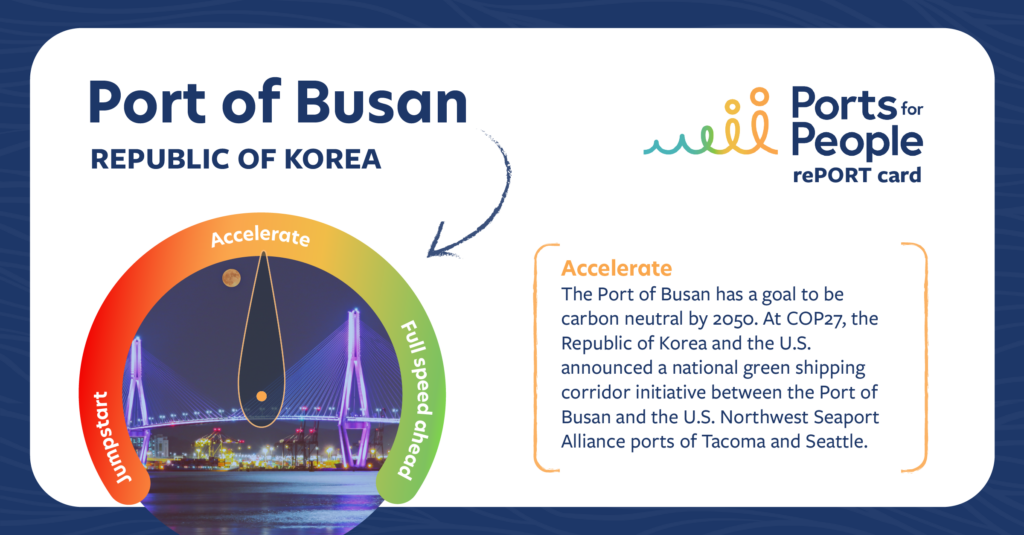
The Busan Port Authority (BPA) is the Republic of Korea’s largest port and the sixth busiest container port in the world, handling 21.59 million TEU each year (2020).
- Commitments – BPA’s current emissions reduction target is 50% reduction of GHG in the public sector by 2030 and carbon neutrality by 2050. The country’s Green New Deal unveiled in 2020 included a commitment to electrify 140 state-owned ferries and harbor vessels at the Busan Port Authority by 2030. On green shipping corridors, BPA is supported by a new commitment from its national government. On November 7, 2022, the Republic of Korea and the U.S. issued a joint statement at COP27 to announce technical collaboration on green shipping corridors. This is a critical step forward for Korea, which did not sign the COP26 Clydebank Declaration on Green Shipping Corridors. Through the Zero-Emission Shipping Mission, the U.S. Department of State, U.S. Department of Energy, Ministry of Foreign Affairs of the Republic of Korea, Ministry of Oceans and Fisheries of the Republic of Korea, and Ministry of Trade, Industry and Energy of the Republic of Korea will “undertake a feasibility study to explore the potential of creating a green shipping corridor between major cargo ports in the Republic of Korea and the United States.” The envisioned corridor will be anchored by the U.S. Northwest Seaport Alliance and the Port of Busan.
- Policies – The port’s carbon neutrality by 2050 plan is still under development, with policies yet to be verifiably implemented.
- Progress – BPA has several renewable energy and energy efficiency projects under development, including plans to build solar power generation facilities in the Woondong Distripark. The Port Authority has made advanced on-shore electrification progress, including electrifying roughly 100 cranes, and plans to unveil its first zero-emission electrified passenger ferry in 2023. BPA’s carbon neutrality plan and recent green shipping corridor announcements will produce feasibility studies to inform future project development.
The Port of Busan can accelerate its commitments to be carbon neutral by 2050 with a specific commitment for zero-emission shipping by 2040. This carve-out would mutually benefit a transpacific green shipping corridor between the Republic of Korea, the U.S. and their ports. In addition, the port should develop and fund a plan to produce and bunker zero-emission fuels for cargo ships and host zero-emission demonstration projects to incentivize deployment and serve as a regional and global leader for zero-emission ship building.
Colón, Panama [Jumpstart]
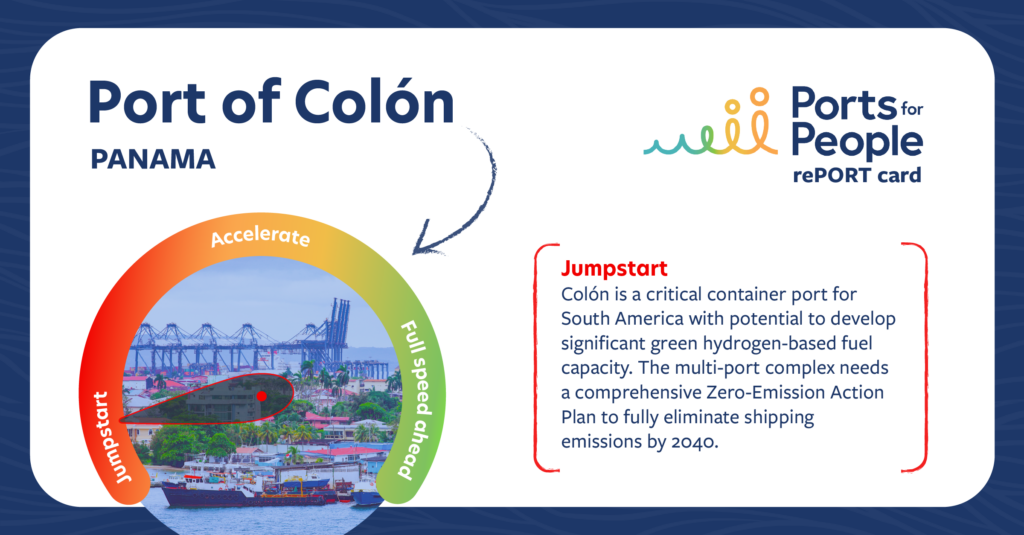
The Colón port complex includes the Colón Container Terminal, the Port of Cristobal and the Manzanillo International Terminal. The port’s container terminal has a throughput of 4.43 million TEU each year (2020), ranking #45 in the world’s top 50.
- Commitments – The port complex has yet to make a commitment to zero-emission shipping, and Panama is not a signatory to the COP26 Clydebank Declaration for Zero-Emission Shipping. Of note, however, is that the Panamanian-owned and operated Panama Canal has been tracking emissions since 2013 and aims to become carbon neutral by 2030. In 2016, the Panama Canal began to bolster their GHG reduction efforts with the Green Connection Environmental Recognition Program and an Emissions Calculator, a tool that not only allows shipping lines to measure their greenhouse gas (GHG) emissions per route, but also strengthens the Canal’s analysis of the emissions produced by its own day-to-day operations.
- Policies – Without a decarbonization commitment in place, the port has yet to adopt policies to mandate zero-emission shipping.
- Progress – Colón is in the process of developing a biorefinery to provide biofuels and green hydrogen at the port. While green hydrogen-based fuels are a strong contender for the hard-to-abate shipping sector, biofuels are not a sustainable option. Biofuels including ethanol and biodiesel are often blended with fossil fuels and require organic matter (biomass) feedstock. With climate change increasingly affecting global food supply systems, we must preserve and prioritize agricultural land to grow food, not biomass feedstock. Moreover, biofuels necessitate the use of bioenergy carbon capture and storage (BECCS) to capture the CO2 that plants release in the fermentation process.
Overall, the Colón port complex needs a systemic approach to achieve decarbonization. For shipping and its container terminal specifically, we encourage the port to develop a Zero-Emission Action Plan that prioritizes zero-emission fuels that do not require blending fossil fuels or carbon capture and storage to achieve carbon neutrality. Zero-emission solutions must be prioritized over net zero options. A jumpstart approach would enable the Colón port complex to put one of South America’s biggest ports on the map as a leader in decarbonization.
Durban, South Africa [Jumpstart]
The Port of Durban is the largest and busiest shipping terminal in Sub-Saharan Africa and a critical port of entry for the African continent. The container terminal has a cargo throughput of 2.6 million TEU (2020).
- Commitments – The Port of Durban has yet to adopt zero-emission standards or commit to zero-emission shipping. South Africa is not a signatory of the Clydebank Declaration.
- Policies – Without commitments in place for zero-emission shipping or national support for green shipping corridors under the Clydebank Declaration, the Port of Durban has yet to adopt policies that demonstrably address emissions. However, the Transnet National Ports Authority provides a 10% reduction on port fees for certified double-hulled liquid bulk tankers, liquid bulk tankers equipped with segregated ballast tanks, and liquid bulk tankers in possession of a “Green Award.” Together with the Ports Regulator of South Africa, the National Port Authority could build upon this fee reduction policy to further incentivize cleaner ships at the port.
- Progress – In February 2022, South Africa released its Hydrogen Society Roadmap, which aims to support a carbon neutral society that is economically inclusive and environmentally stable. The Roadmap establishes several targets, including the creation of an export market for green hydrogen and ammonia, the implementation of a Center of Excellence in manufacturing for hydrogen products, the development of domestic hydrogen supply chains, the production of 500 kilotons of green hydrogen by 2030, and a long-term target of 15 gigawatt (GW) power generation based on hydrogen by 2040. Complementary to these efforts, the Port of Durban is in the process of developing a renewable energy shore-power strategy and has requested the private sector to submit proposals for renewable energy projects at the ports. In October 2022, the industry hosted the World Maritime Day South Africa, demonstrating the significance of shipping’s place in the South African economy. Together, these progress steps demonstrate South Africa and the Port of Durban’s potential to be a leader in clean energy for the maritime sector and the energy industry at large.
The Port of Durban is one of eight commercial ports in South Africa and has the potential to spearhead the country’s position as a global supplier of green hydrogen-based maritime fuels. To support its efforts and investments on clean energy development, the Port must adopt policies to fully utilize these resources, including shore-power mandates and clean-fuel standards for vessels. To expand its impact, the Port can establish green shipping corridors with port partners, serving as a key bunkering port for green hydrogen-based fuels and reliable renewable electricity supply.
Hong Kong, S.A.R., China [Jumpstart]
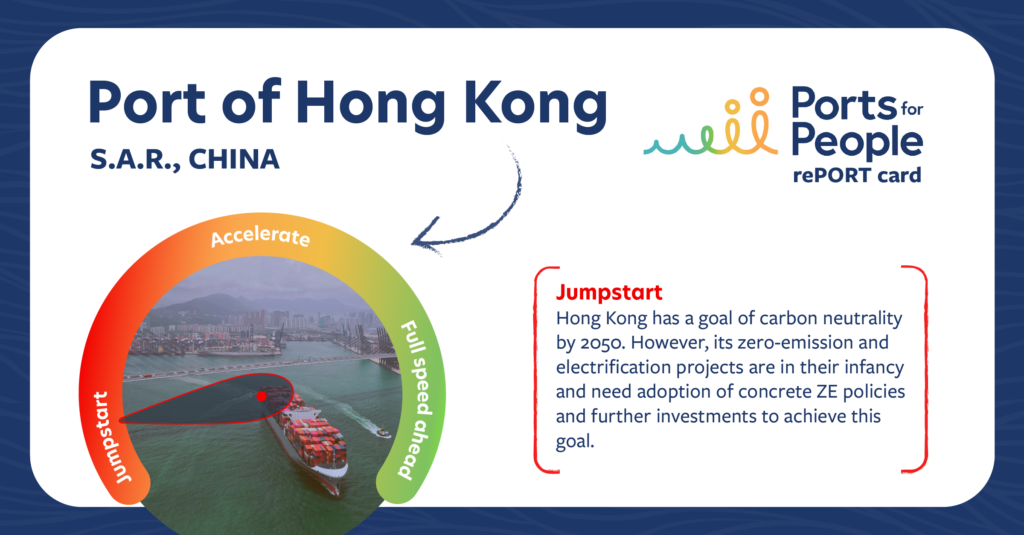
The Port of Hong Kong is the eighth largest port in the world, handling 18.3 TEU in 2020. In addition to serving as a key hub in the South Asian Pacific, the Port is part of the ancient maritime Silk Road, an integral trade route in Asia.
- Commitments – Hong Kong pledged to achieve carbon neutrality by 2050, and the Port of Hong Kong is part of this pledge. The carbon neutrality plan includes a commitment to developing hydrogen fuel cell propulsion systems for heavy duty transportation. However, the port complex has yet to take clear implementation steps necessary to achieve its maritime goals. Hong Kong has not signed the Clydebank Declaration or committed to green shipping corridors or alliances.
- Policies – Since 2019, China’s maritime authority has banned the discharge of wash water from open-loop scrubbers to comply with International Maritime Organization (IMO) rules for Emission Control Areas (ECAs). However, beyond this policy, Hong Kong trails behind other major international ports on policies to incentivize clean ships and to phase out the most heavily polluting fuels.
- Progress – In 2021, Hong Kong announced a HK$350 million investment to implement a pilot scheme on electric ferries, with plans to launch the first ferries in 2023. The pilot scheme is part of the government’s Clean Air Plan for Hong Kong 2035. Progress on the pilot is unclear, and the Port does not yet provide renewable shore power to provide electric ferries with clean electricity. Beyond the ferry pilot, the Port of Hong Kong is also in the early stages of developing a strategy for cleaner fuels, including green hydrogen.
Although Hong Kong is one of the busiest ports in the world, it has yet to make significant commitments or investments toward decarbonization beyond the electric ferry pilot. We encourage the port to jumpstart its transition by creating a Zero-Emission Action Plan to achieve zero-emission shipping by 2040 and portwide carbon neutrality by 2050. We further encourage the port to adopt concrete zero-emission policies and mandates for clean fuels and establish itself as a leading provider for zero-emission or ZE, maritime fuels for the region. Its progress on the electric ferry pilot in 2023 will be a key indicator of the port’s movement toward decarbonization.
Port Klang, Malaysia [Jumpstart]
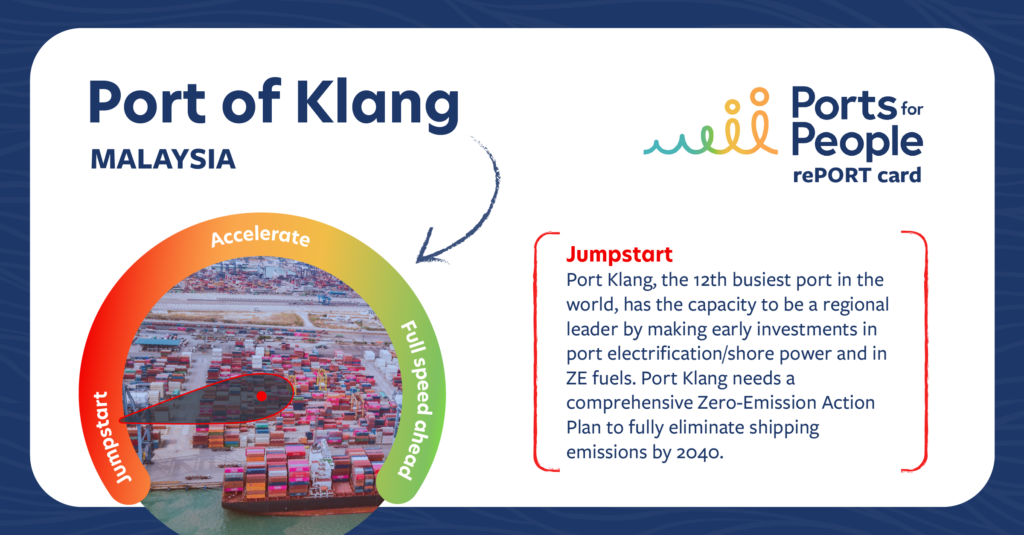
Port Klang is the largest port in Malaysia and the 12th largest port in the world, with a cargo throughput of 13.24 million TEU in 2020. In 2020, the Port was awarded the APSN (APEC Port Services Network) Green Port 2020 unification for the second time since 2017. The award recognizes the Port’s several green initiative programs, including “solar energy, conservation, replacement of conventional lighting with LED lighting, investing in more energy-efficient and environmentally friendly cargo handling fleets, monitoring carbon emissions from port equipment and vehicles, marine water quality monitoring and treatment before being released into port waters, paperless transactions, waste management standard operating procedures and other ongoing green initiatives.”
- Commitments – The Port considers part of its mission to “ensure supply-driven and environmentally sustainable port infrastructure facilities and services,” but the Port does not have a dedicated commitment to zero-emission shipping. In June 2022, the Port and Ministry of Transport hosted the biennial International Harbour Masters’ Association (IHMA) Congress to discuss sustainable capacity building, decarbonization, digitalization, safe maritime transport and emerging green technologies. Malaysia is not a party to the Clydebank Declaration.
- Policies – In 2019, Malaysia banned open-loop scrubbers ahead of the 2020 IMO rule. It is unclear whether the port has adopted specific policies to drive decarbonization from ships that call its port.
- Progress – Despite admirable efforts on energy efficiency and emissions reductions on port side equipment and vehicles, the Port has made little progress to support decarbonization of ocean-going vessels. Providing clean electricity and mandating zero-emission fuels from ships will be key to Port Klang’s progress.
Port Klang is a leader in its region for port side energy efficiency and reducing emissions from cargo handling equipment and vehicles; however, it has not yet taken the steps necessary to jumpstart the transition to zero-emission shipping. It must adopt and implement a Zero-Emission Action Plan to address emissions from ocean-going vessels and dedicate infrastructure investment to provide ships with renewable shore power and zero-emission fuels. Port Klang can help activate ports in the region by leading development on a green shipping corridor network for Southeast Asian terminals — thereby demonstrating leadership as a Green Port and delivering on its mission to ensure environmentally sustainable port infrastructure facilities and services.
Long Beach, CA, USA [Full speed ahead]
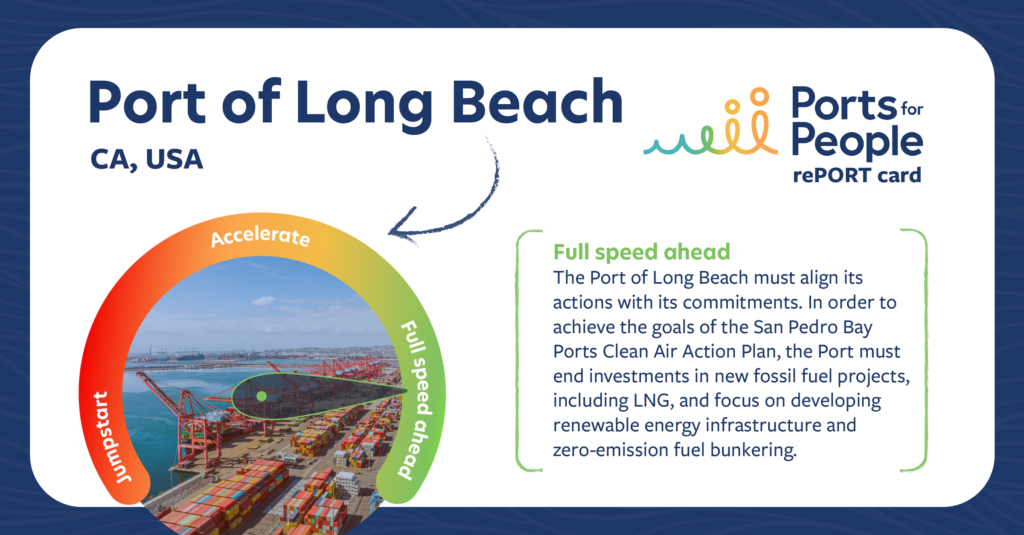
The Port of Long Beach is part of the San Pedro Bay Port Complex, along with its sister Port of Los Angeles. On its own, the Port of Long Beach is the 22nd largest container port in the world, handling a record 9.38 million TEU in 2021, compared to 8.11 million TEU in 2020. Together with LA, it is the largest port complex in the U.S.
- Commitments – In 2006, the ports of Los Angeles and Long Beach created and approved the San Pedro Bay Ports Clean Air Action Plan (CAAP), in an effort to improve air quality in the South Coast air basin and to reduce emissions at the ports. In 2017, the ports updated the CAAP to include greenhouse gas (GHG) emission reduction targets of 40% below 1990 levels by 2030 and 80% below 1990 levels by 2050. On green shipping corridors, Long Beach is collaborating with the ports of Los Angeles, Shanghai and Singapore in two green shipping corridor initiatives — the LA-LB-Shanghai Green Shipping Corridor and the LA-LB-Singapore Green & Digital Shipping Corridor. The LA-LB-Shanghai Corridor is expected to release its implementation plan at COP27 in November 2022, where the LA-LB-Singapore Corridor talks have just begun. Given the United States’ leadership of the U.S. Green Shipping Challenge, it is imperative that U.S. ports like Long Beach also take a leadership role in developing green corridor networks to encompass all major global trading routes.
- Policies – Through the CAAP and state regulatory requirements by the California Air Resources Board (CARB), which regulates mobile sources of air quality pollutants and emissions, the Port of Long Beach has several policies to regulate emissions from ships. CARB’s onshore power requirements and harbor craft electrification regulations help reduce emissions from vessels in-port and at berth. These same regulations apply to the Port of Los Angeles. The Port of Long Beach has also adopted voluntary vessel slow-down programs to reduce pollutants and emissions. However, the Port has failed to implement many of the commitments made in the CAAP even after five years. In addition, record cargo volumes, port congestion and pandemic-driven pressure on global supply chains have resulted in increased emissions, further moving the port from its emission reductions targets. To counter the uptick in trade, the Port must adopt policies to incentivize cleaner ships and phase out the dirtiest, most heavily polluting fuels from entering the San Pedro Bay. Together with the Port of Los Angeles, it has the economic power and leverage to be a first mover, zero-emission shipping port.
- Progress – Despite its ambitious commitments and dedication to green shipping corridor development, the Port of Long Beach has several problematic perspectives on decarbonization. Namely, the Port is considering developing liquefied natural gas (LNG) bunkering facilities at the port, based on proposed updates to the Port Master Plan. If approved, these changes would allow for the development of LNG bunkering at Pier S, locking in fossil fuel pollution and GHG emissions in the San Pedro Bay and the South Coast air basin for decades. The Port must move full speed ahead on its decarbonization plans and reject fossil fuels like LNG. The Port is also pursuing a channel deepening project to make way for larger ships at the Port, despite the environmental impacts and climate resiliency impact of such expansion.
The Port of Long Beach has the benefit of immense financial support for sustainable infrastructure development, both from its national and state governments. In addition to existing funding through the U.S. Department of Transportation Maritime Administration (MARAD) Port Infrastructure Development Program (PIDP), U.S. ports will have access to more than US$3 billion in funding through the 2022 Inflation Reduction Act. The Port of Long Beach must leverage these funds to ensure 100% renewable shore power, develop capacity for zero-emission fuel bunkering and fully electrify port operations.
Los Angeles, CA, USA [Full speed ahead]
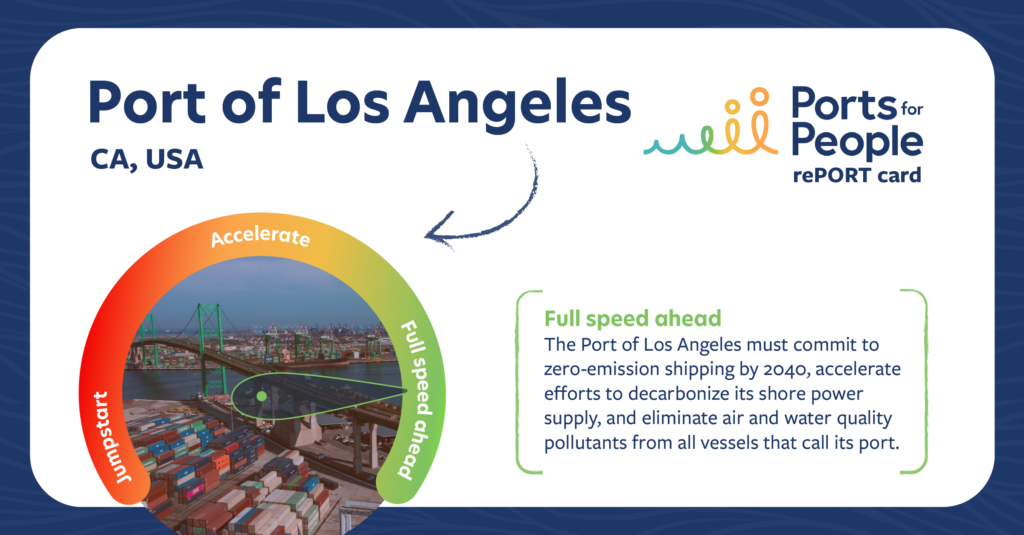
On its own, the Port of Los Angeles is the 17th largest container port in the world, processing 9.2 million TEU in 2020 (10.8 million in their fiscal year 2020/21 ending June 30, 2021). Together with the Port of Long Beach, it is the largest container port in North America and one of the largest port complexes in the world.
- Commitments – The Port of Los Angeles’ commitments on zero-emission shipping closely mirror the Port of Long Beach: it is party to the San Pedro Bay Ports Clean Air Action Plan (CAAP) and a partner on the green corridor development between the ports of LA-LB-Shanghai and LA-LB-Singapore (for more detail on these corridor commitments, see the Long Beach analysis above). Together with the Port of Long Beach, the Port of Los Angeles has a responsibility as a key entry point to the U.S., the Pacific West Coast — and the West writ large — to be an environmental steward and leader on climate mitigation and adaptation.
- Policies – Beyond CAAP and the state CARB regulations for shore power and harbor craft electrification (detailed in the Long Beach analysis above), the Port has yet to adopt policies mandating zero-emission vessels. Along with its partner Port of Long Beach, the Port of Los Angeles also has a voluntary vessel slow-down program. Per the Port’s website, “the objective of the Vessel Speed Reduction Program (VSRP) is to reduce diesel particulate matter (DPM), nitrous oxides (NOx), and greenhouse gasses (GHG) emissions from Ocean-Going Vessels (OGV) by slowing their speeds as they approach or depart the Port, at 20 or 40 nautical miles from Point Fermin. A voluntary VSRP was established in 2001 with the signing of a cooperative Memorandum of Understanding among the ports of Los Angeles and Long Beach, U.S. Environmental Protection Agency, California Air Resources Board, South Coast Air Quality Management District, Steamship Association of Southern California, and Pacific Merchant Shipping Association. The Port of Los Angeles provides an incentive on an annual basis and does not require registration at this time.”
- Progress – In addition to its ongoing green corridor development initiatives, the Port has promising potential to serve as a key clean energy fuel hub for the shipping industry. The City of Los Angeles is collaborating with local and state government, labor and industry partners to pursue development of a green hydrogen hub in Los Angeles, with plans to apply for funding from the U.S. Department of Energy. As this initiative progresses, it is imperative that environmental justice be prioritized to ensure a just transition and an equitable future for all.
Despite its progress on green shipping corridor commitments, a recent editorial from the LA Times revealed staggering statistics on pollution at the Port of LA: a 147% jump in diesel particulate matter and a 136% increase in greenhouse gas emissions in 2021 over the previous year — primarily from ocean-going vessels. The trend is inexcusable. The San Pedro Bay Ports must leverage their authority and economic power to immediately mandate cleaner ships and move toward 100% renewable shore power.
The Port of Los Angeles holds enormous power and responsibility in the shipping industry. Together with its federal, state and local government and port partners, the Port must commit to zero-emission shipping by 2040, accelerate efforts to decarbonize its shore power supply, and eliminate air and water quality pollutants from all vessels that call its port.
Manzanillo, Mexico [Jumpstart]

The Port of Manzanillo in Colima, Mexico is the largest containerized port in the country and serves as a gateway for international trade in Mexico and the region. In 2020, the Port processed 1 million TEU.
- Commitments – Mexico is not a party to the Clydebank Declaration, and its national commitments to reduce emissions are highly insufficient to meet a 1.5 degree Celsius scenario. This is due in large part to the country’s economic reliance on its fossil fuel resources. Transitioning to a clean energy future will require a national commitment to prioritize climate mitigation and adaptation, and moving toward producing clean energy in place of heavily-polluting fossil fuels.
- Policies – The Port does not currently have policies mandating in-port emissions reductions, shore power or any policies to incentivize or require clean ships. Policy development is an integral first step for the Port’s Zero-Emission Action Plan.
- Progress – As one of the largest ports in the region, the Port must consider the climate impact of port expansion projects. Infrastructure funding should prioritize renewable electrification and developing capacity and supply for zero-emission fuels.
In July 2022, the Global Maritime Forum and the University College London published a report on the strategic opportunities available to Mexican ports in the transition to zero-emission shipping. The report identified the Port of Manzanillo as a potential green hydrogen hub for global shipping and other hard-to-abate industry sectors. By shifting focus from port expansion to a clean energy transition, the Port could become a global leader for zero-emission fuel bunkering and export — leading Mexico onto a path aligned with a 1.5 degree Celsius scenario.
Oslo, Norway [Full speed ahead]

Norway’s largest port, located in its capital city of Oslo, has an ambitious vision to become one of the world’s first emissions-free ports. With an annual throughput of approximately 808,100 TEU in 2020, the Port aims to achieve a 50% increase in cargo traffic by 2030 — hoping to move trade from road to sea. On the same trajectory, the Port has a goal to reduce total CO2 emissions 85% by 2030. Overall, the Port has a goal to become the most efficient and environmentally-friendly urban port.
- Commitments – The Port of Oslo has a dedicated and clear set of climate and environmental goals and priorities. Its goal to reduce total CO2 emissions 85% by 2030 and to become one of the world’s first emissions-free ports is by far the most ambitious zero-emission target set by ports to date. Nationally, Norway is a signatory of the Clydebank Declaration and a partner with the U.S. on the Green Shipping Challenge — providing crucial national support to the Port of Oslo’s zero-emission goals.
- Policies – The Port’s ambitious climate and environmental goals will require clear policy mandates for zero-emission shipping. By setting interim targets, the Port will be able to prioritize the development of the infrastructure and programs necessary to achieve these goals.
- Progress – Port electrification is well underway at the Port of Oslo. The Yilport Oslo container terminal is Norway’s most modern terminal. The terminal already has zero-emission electric cranes and electrified loaders and smaller vehicles. The next step in its vision of becoming an emissions-free terminal is acquiring electric terminal tractors and electric-Reach stackers. This zero-emission infrastructure will serve as a solid foundation to support zero-emission vessels with shore power.
The Port’s prioritization of efficiency and sustainability will provide long-term economic, climate and public health benefits to Oslo and the region. By prioritizing shipping in its climate action efforts, Norway has stepped out as a global leader on shipping decarbonization and a sustainable clean energy future for cities like Oslo. Building upon its progress to date, the Port of Oslo must adopt clear policies to mandate shore power for all vessels at berth and phase out fossil fuels from all vessel types that call its port.
Rotterdam, The Netherlands [Accelerate]
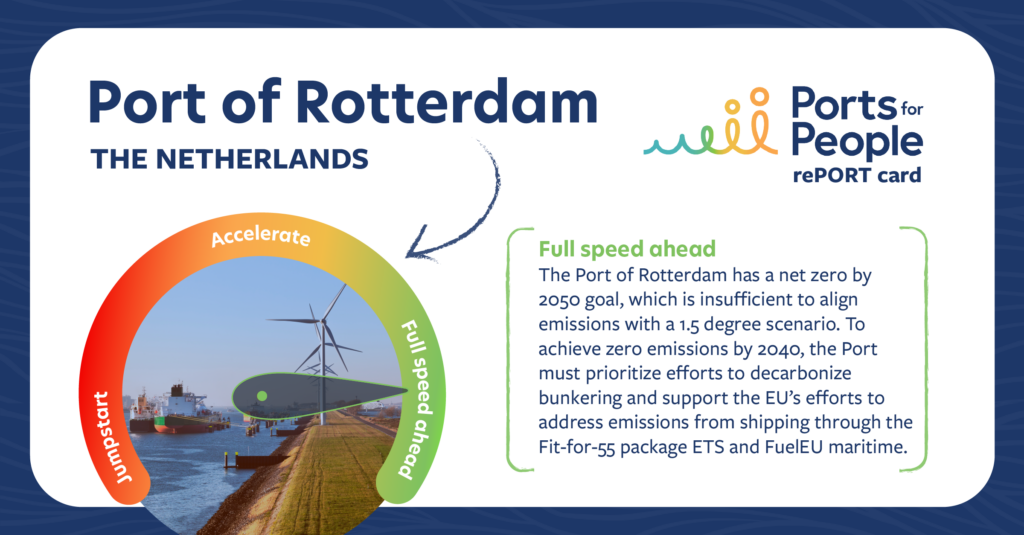
Rotterdam is the 10th largest port in the world and a key port for transshipment of cargo. It is the largest seaport in Europe and the largest seaport outside of East Asia. It handles more than 14 million TEU every year (2020). The Port of Rotterdam is also the most heavily polluting port in Europe, as shipping traffic to and from Rotterdam and the handling of vessels in the port produce 13.7 million tons of CO2 emissions every year.
- Commitments – The Port’s energy transition strategy aims to achieve CO2-neutral energy management and a fully circular industry by 2050 (in other words, net zero by 2050). The Netherlands is a party to the Clydebank Declaration, and the Port of Rotterdam has established several green corridor initiatives since the Declaration was signed in 2021. In August 2022, the Port announced a partnership with the Maritime and Port Authority of Singapore to establish the world’s longest green and digital corridor. To reinforce the European Green Corridors Network launched in March 2022 by the Mærsk Mc-Kinney Møller Center for Zero-Carbon Shipping, Rotterdam also joined forces with Gothenburg to establish a green corridor between their ports and to a larger network of deep-sea corridors. The Port also committed that by 2028, the largest container ships, passenger and roll-on/roll-off segments will use onshore power and to have the first zero-emission vessel in use by 2030.
- Policies – The Port rewards ships with better (supra-legal) environmental performance with a discount on seaport dues. Additional discounts are available for vessels that monitor their own noise production. As Port of Rotterdam implements its green corridor initiatives, it will need to adopt progressive policies to phase out fossil-fueled ships from calling its port and mandate zero-emission shore-power and fuel bunkering.
- Progress – Rotterdam has several demonstration projects focused on reducing transport emissions through sustainable fuel and propulsion, improved efficiency and modal shift. In an effort to maintain its position as a key bunkering port, the Port of Rotterdam is working with partners to develop a large-scale hydrogen network across the port complex. The Port aims to become an international hub for hydrogen production, import, application and transport to other countries in Northwest Europe.
As one of the world’s largest ports, the Port of Rotterdam has the economic power and moral imperative to support a rapid transition to zero-emission shipping. To align with a 1.5 degree Celsius scenario, the Port must commit to zero emissions by 2040. Its work on green corridors should prioritize efforts to electrify operations portwide, including shore power, and to decarbonize its fuel bunkering. In doing so, the Port will send market signals to the shipping industry that ships calling its port will have reliable access to zero-emission fuels and clean shore power. To start, the Port must work to support the European Union’s Fit-for-55 package of policies targeting shipping emissions, including the incorporation of shipping emissions in the bloc’s Emissions Trading System (ETS) and the FuelEU maritime policies. This regional policy is a critical foundation for the Port to achieve its goals.
Santos, Brazil [Jumpstart]
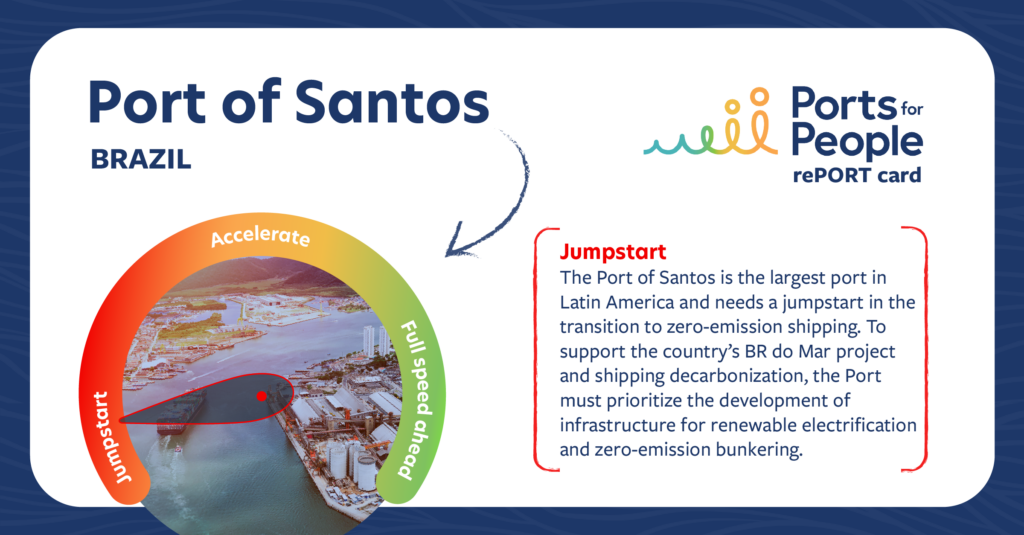
The Port of Santos, Brazil is the largest port in Latin America and the 46th largest container port in the world, handling 4.23 TEU annually (2020). Approximately 27% of the country’s trade balance (US$112.3 billion) passes through the port. The public port is undergoing privatization, but it is unclear when the process will conclude and how it will impact the port’s transition to zero-emission shipping.
- Commitments – Brazil is not a party to the Clydebank Declaration, and the Port has yet to make commitments toward zero-emission shipping or decarbonized corridors. But in 2020, the federal government of Brazil created a project called BR do Mar, which aims to (i) promote greater balance in the transport matrix, which is heavily focused on road transport; (ii) reduce coastal or “cabotage” transportation costs and bureaucracy; (iii) increase chartering possibilities and vessel supply; and (iv) encourage market competition. BR do Mar is expected to lead to a 40% increase in the cabotage fleet in three years and a 65% increase in the amount of cargo transported by containers.
- Policies – The Port does not provide wharfage rate or fee discounts for clean ships or otherwise mandate shore power or clean fuels for vessels. Policy development in the years to come will require a unified approach from the port’s private ownership and the federal BR do Mar project.
- Progress – The government’s BR do Mar project demonstrates the value of an efficient transport system, but increased trade by container ship will increase emissions from shipping if decarbonization policies and infrastructure are not prioritized. The Port can jumpstart its zero-emission transition by developing infrastructure for renewable electrification and zero-emission bunkering as the country works to achieve the aims of the BR do Mar project.
In July 2022, the International Council on Clean Transportation (ICCT) issued a working paper on the BR do Mar project and prospects for growth with decarbonization. The ICCT concluded that “the expected cabotage expansion in the new regulatory environment represents a great opportunity to attract investments for efficient and clean infrastructure development in the country.” This paper provides an excellent overview of Brazil’s opportunities to contribute to the international maritime sector’s decarbonization goals.
Shanghai, China [Accelerate]
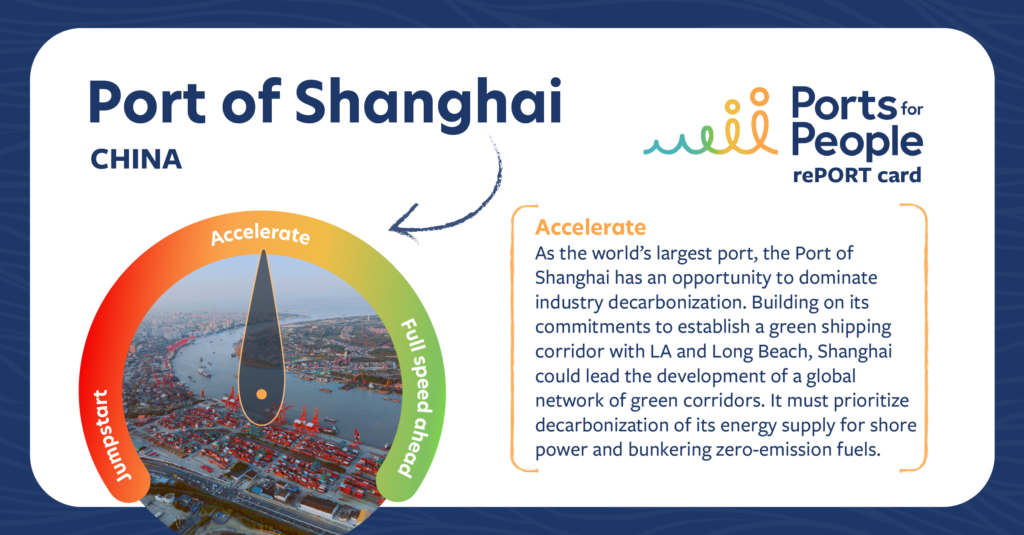
The Chinese Port of Shanghai has been the world’s largest port since 2010. The Port complex includes a deep-sea port and a river port. Shanghai is one of only four port cities in the world to be categorized as a large-port Megacity, due to its high volumes of port traffic and large urban population. The Port of Shanghai moves more than 43.5 million TEU every year (2020).
- Commitments – Nationally, China has a goal of carbon neutrality by 2060, but the Port of Shanghai does not have a dedicated commitment for zero-emission shipping. While China is not a party to the Clydebank Declaration, the Port of Shanghai entered into the first transpacific green shipping corridor partnership with the Ports of Los Angeles and Long Beach, with implementation plans expected at COP27 in November 2022.
- Policies – To realize a transpacific green corridor on one of the busiest global trading routes — between the Port of Shanghai and the San Pedro Bay Ports of LA and Long Beach — Shanghai will need to adopt aggressive policies to mandate clean shore power and zero-emission fuels. These policies do not yet exist but will hopefully be part of the corridor’s implementation plan.
- Progress – China has invested significantly in shore power, and the Port of Shanghai is receiving additional investments in shore power in the near future. Now, the Port must work to decarbonize the electricity supply for this shore power.
As the world’s largest port, the Port of Shanghai has an opportunity to lead and shape maritime decarbonization. Building on its commitments to establish a green shipping corridor with the Ports of LA and Long Beach, the Port of Shanghai could lead the development of a global network of green corridors. Shanghai can right the industry ship onto a 1.5 degree trajectory, activating the global supply chain to build zero-emission-fueled ships, produce, transport and bunker scalable zero-emission fuels, and incentivize port-wide decarbonization.
Singapore [Full speed ahead]
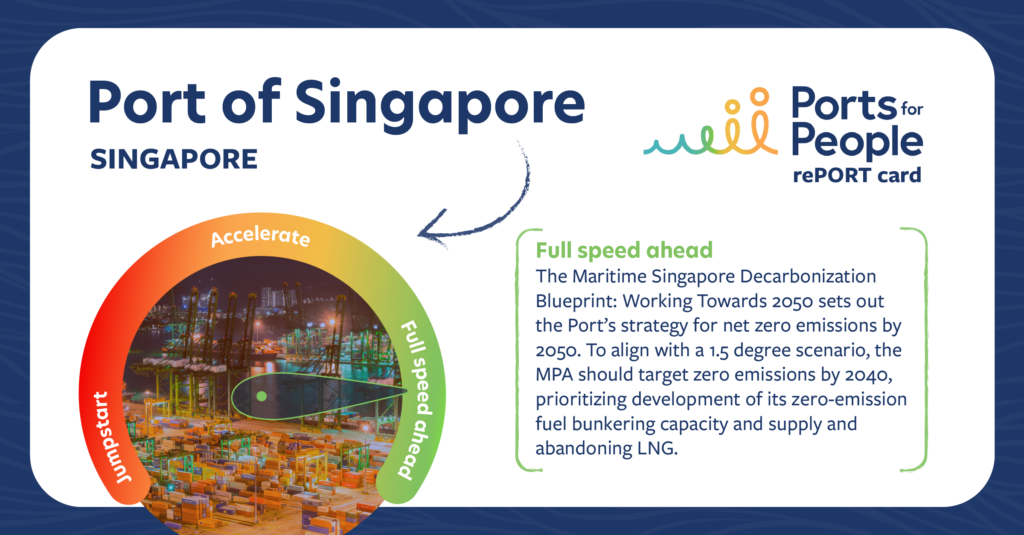
Singapore is the world’s second largest port and the world’s busiest transshipment port. Moving more than 36.6 TEU annually (2020) and bunkering fleets around the world, Singapore is a global leader in the shipping industry.
- Commitments – Developed by the Maritime and Port Authority of Singapore (MPA), the Maritime Singapore Decarbonisation Blueprint: Working Towards 2050 sets out the Port´s strategy for net zero emissions by 2050. The Blueprint outlines seven focus areas to support the decarbonization of the maritime industry, including: (i) port terminals; (ii) domestic harbor craft; (iii) future marine fuels, bunkering standards and infrastructure; (iv) Singapore Registry of Ships; (v) efforts at IMO and other international platforms; (vi) research & development and talent; and (vii) carbon awareness, carbon accounting and green financing. Party to the Clydebank Declaration, Singapore has entered into green shipping corridor commitments with the ports of Rotterdam, LA and Long Beach, and the country of Australia in a first of its kind Green Economy Agreement.
- Policies – The Maritime Singapore Green Initiative comprises four voluntary programs to incentivize companies to adopt clean and green shipping practices over and above the minimum required by International Maritime Organization (IMO) Conventions.
- Progress – Together with its green corridor commitments, the Port’s progressive incentive programs and ambitious decarbonization blueprint demonstrate the Port’s willingness to be a first mover on industry decarbonization. However, the Port’s plans to provide LNG bunkering are inconsistent with its climate goals, given LNG’s potent methane emissions and contributions to global warming.
Tanger Med, Morocco [Jumpstart]
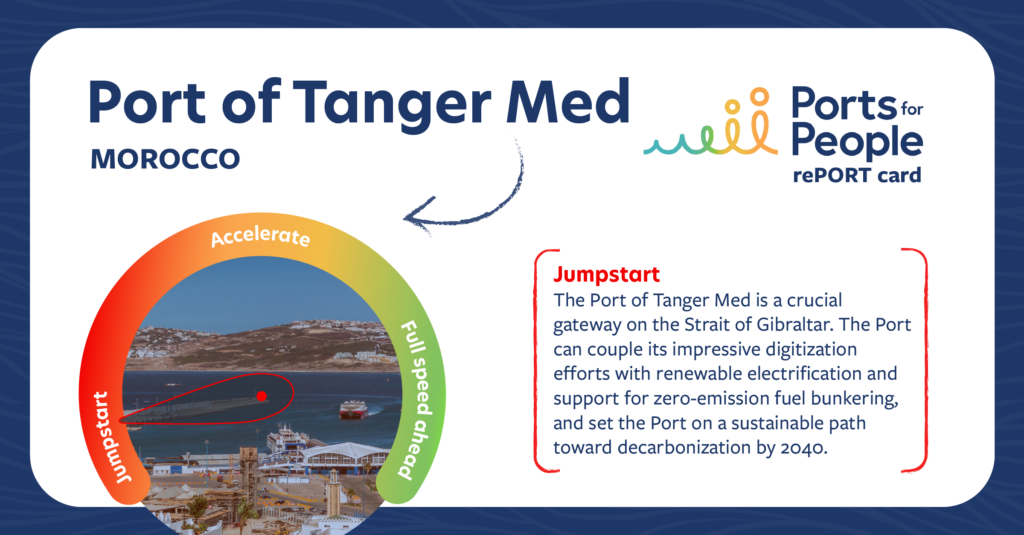
The world´s 37th busiest container port is Tanger Med, Morocco. Because of its proximity to Europe and its location in the Strait of Gibraltar — where the Atlantic meets the Mediterranean — Tanger Med is the top port in Africa, as well. Consisting of four container terminals, one RoRo terminal, one hydrocarbon terminal, two automobile terminals and one bulk terminal, the Port of Tanger Med is experiencing year-over-year trade growth, moving 5.8 million TEU in 2020. Today, the Port reports moving more than 7.17 million TEU annually.
- Commitments – The Port Authority has obtained the “Ecoports” label and the Port Environmental Review System (PERS) certification granted by the European Sea Ports Organisation (EPSO), but its focus is primarily on ecological impact and waste.
- Policies – To ensure air quality and compliance with national and international standards, the Tanger Med Port Authority ensures: (i) a system of annual air quality inspection through the analysis of samples by accredited laboratories; (ii) the implementation of a fixed reservation system in order to optimize the waiting time of vessels in the harbor; (iii) sending certificates of conformity for gas purification systems to Tanger Med Port before the vessel calls; and (iv) prohibition of wastewater discharge from gas scrubbers installed aboard vessels.
- Progress – Tanger Med has deployed digitization to reduce congestion, thereby reducing in-port emissions and pollution. A tenant of the Port, APM Terminals MedPort Tangier, invests in emissions-reducing equipment, including fully electric or hybrid terminal equipment, automated mooring technology and potential shore power. The investment is part of APM Terminals‘ global commitment to achieving a 70% reduction in absolute emissions by 2030 and net zero emissions by 2040.
Given the Port’s growth trajectory, it is vital that Tanger Med jumpstart its Zero-Emission Action Plan as quickly as possible. The Port can couple its impressive digitization efforts with renewable electrification and support for zero-emission fuel bunkering, and set the Port on a sustainable path toward decarbonization by 2040.
Vancouver, B.C., Canada [Full speed ahead]
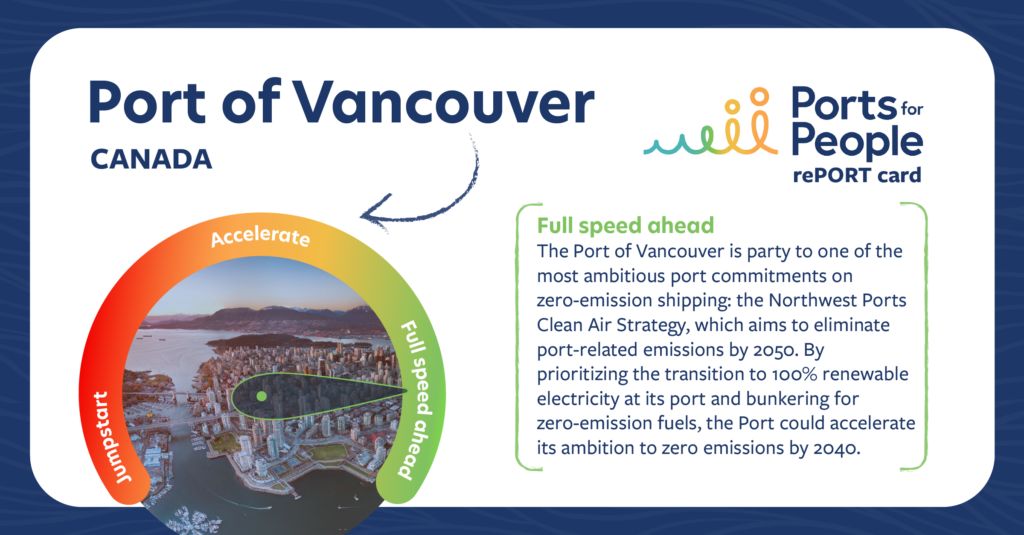
The Port of Vancouver is Canada’s largest port with 29 terminals for bulk, containers, breakbulk and project cargo, automobiles and cruise. Enabling the trade of approximately CA$275 billion in goods, the Port of Vancouver sustains 115,300 jobs, CA$7 billion in wages, and CA$11.9 billion in gross domestic product (GDP) across Canada. In 2020, the Port moved 3.4 million TEU.
- Commitments – The Port of Vancouver is part of the Northwest Ports Clean Air Strategy (NPCAS), a collaborative strategy by the ports of Seattle, Tacoma, the Northwest Seaport Alliance and the Port of Vancouver. The NPCAS set a goal of phasing out all port-related emissions by 2050 — making it one of the most ambitious commitments from ports in the world. On green corridors, Canada is party to the Clydebank Declaration, but the Port of Vancouver has yet to enter publicly into a green shipping corridor commitment with a partner port.
- Policies – The most notable climate and environmental policy at the Port of Vancouver is its EcoAction Program, which provides for reduced fees for clean ships. Through the program, shipping lines may qualify their ships for gold, silver or bronze level discounts by meeting voluntary, industry best practices such as obtaining third-party environmental designations or using technologies that reduce underwater noise and emissions. The Port is also well-recognized for its vessel slow-down program, aimed at protecting marine wildlife including orcas. The port authority-led Enhancing Cetacean Habitat and Observation (ECHO) Program coordinates a voluntary ship slow-down in Haro Strait and Boundary Pass in collaboration with government, the marine transportation industry, environmental groups and Indigenous communities. Vessel slow-down mandates help reduce underwater noise from vessel engines and reduce whale strikes. The Port also has banned scrubber discharge in its waters to comply with IMO regulations, further improving water quality for marine life and coastal ecosystems. For ships at berth, the Port has policies mandating cruise ships and some container ships to plug in to shore power, but the mandate does not apply to all ocean-going vessels, nor is the port’s energy supply 100% renewable.
- Progress – The Port of Vancouver must transition to 100% renewable shore power and electrification and prioritize development of zero-emission fuel bunkering capacity and supply.
The Port has made great strides through its EcoAction program and the Northwest Ports Clean Air Strategy. To further incentivize adoption of the EcoAction program — and to achieve its zero-emission goals — the Port should prioritize development of clean energy infrastructure including 100% renewable shore power and bunkering for zero-emission fuels, and it must abandon all plans to support LNG bunkering.
